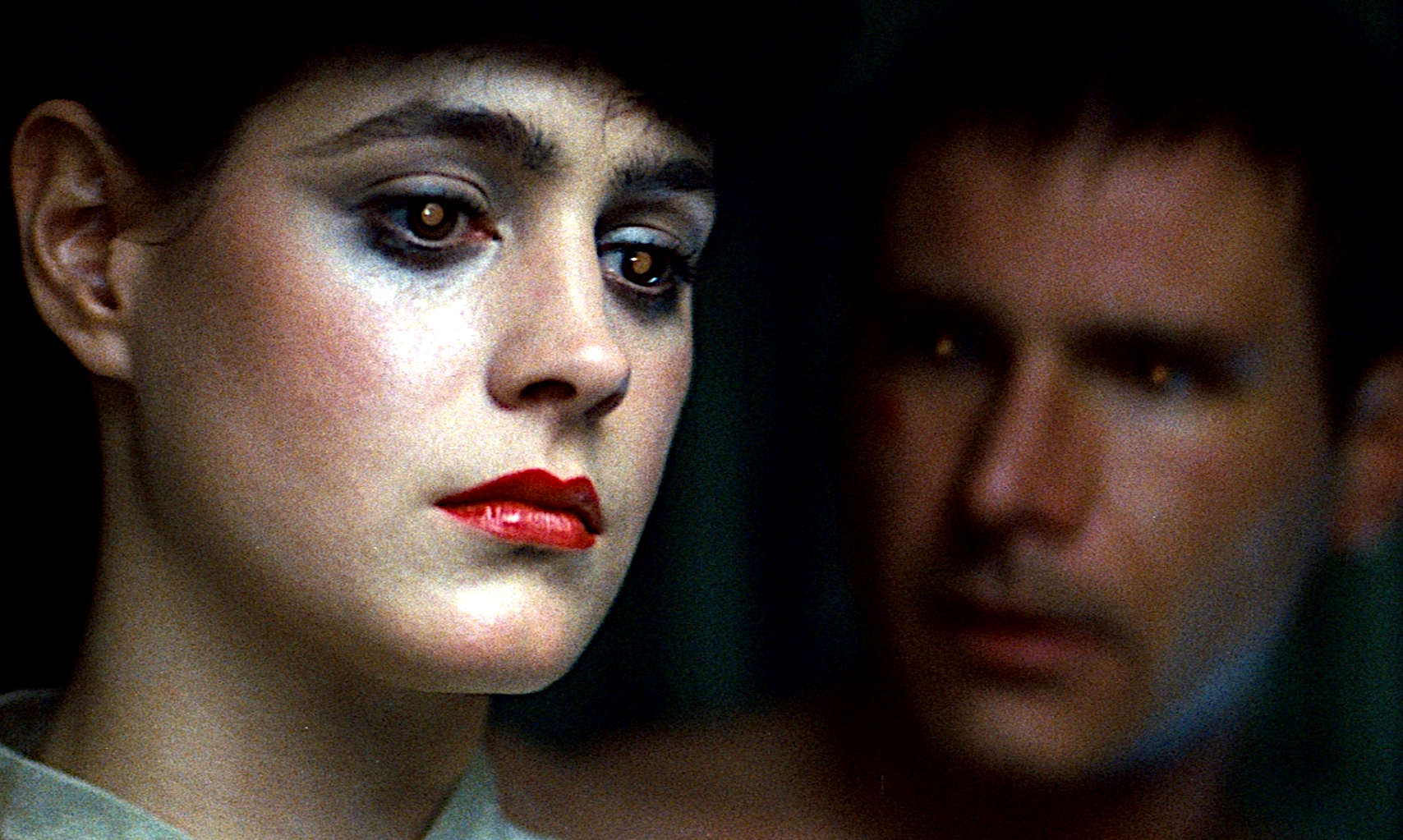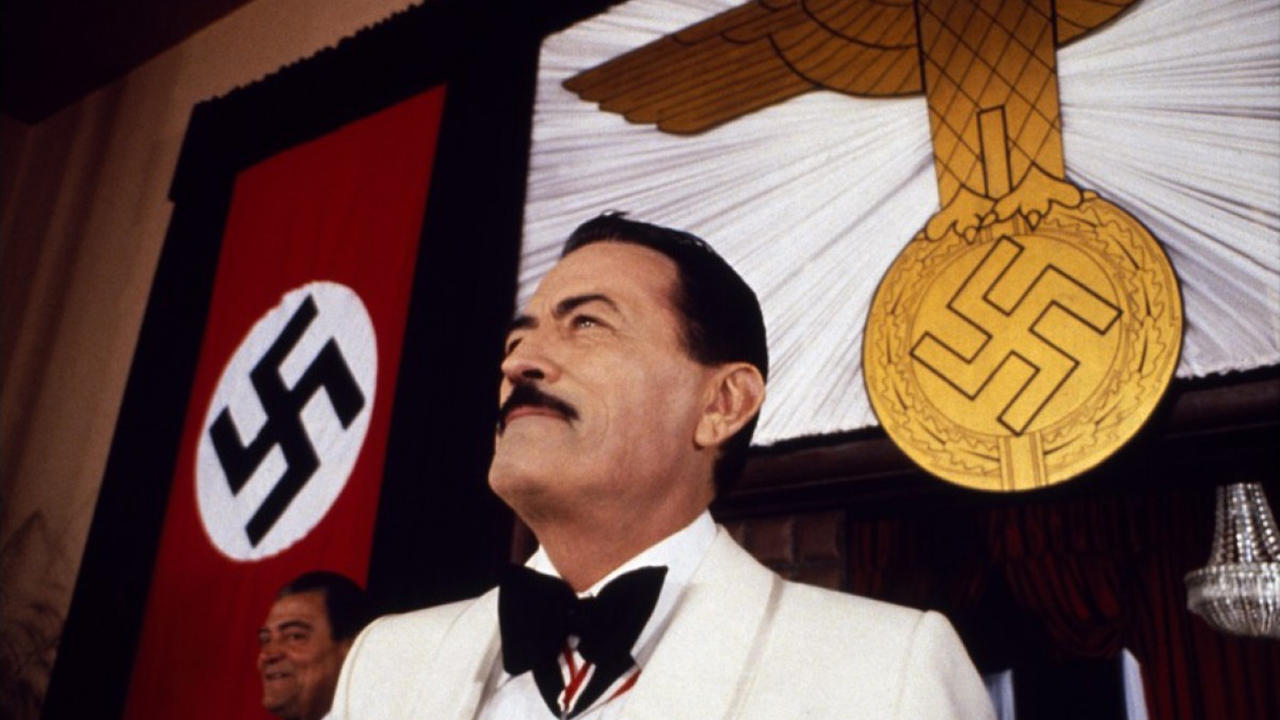|

Sean
Young plays 'Rachel,' the replicant that Rick Deckard
(Harrison Ford) falls in love with.
The replication of biological organisms from a pre-existing
DNA sequence, has been proven to
work very effectively with animals. This is commonly called cloning.
The cloning of dinosaurs is thus entirely feasible, provided
that DNA samples of a suitably high quality are located - or
may be repaired by splicing good code, into damaged
sections of the genome.
Where
slavery has been abolished (save for financial servitude) it
is possible that humans might try to create another race
that is not protected by the laws of man. Since it is in our
makeup to seek to profit from the toil of others. The object
is to get rich, regardless of any moral implications. The
wealthiest being virtually devoid of morality when it comes
to profiteering. Witness the rash of billionaires,
exploiting planet earth, despite global
warming, energy
poverty and ocean
pollution.
Blade Runner is a 1982 science fiction film directed by
Ridley
Scott, and adapted by Hampton Fancher and David Peoples. Starring Harrison Ford, Rutger Hauer, Sean Young, and Edward James
Olmos.
It
is an adaptation of Philip K. Dick's 1968 novel "Do Androids Dream of Electric Sheep?" The film is set in a dystopian future Los Angeles of 2019, in which synthetic humans known as replicants are bio-engineered by the powerful Tyrell Corporation to work on space colonies. When a fugitive group of advanced replicants led by Roy Batty (Hauer) escapes back to Earth, burnt-out cop Rick Deckard (Ford) reluctantly agrees to hunt them down.
Blade Runner initially underperformed in North American theaters and polarized critics; some praised its thematic complexity and visuals, while others critiqued its slow pacing and lack of action. It later became an acclaimed cult film regarded as one of the all-time best science fiction films. Hailed for its production design depicting a high-tech but decaying future, Blade Runner is often regarded as both a leading example of neo-noir cinema as well as a foundational work of the cyberpunk genre. The film's soundtrack, composed by Vangelis, was nominated in 1982 for a BAFTA and a Golden Globe as best original score.
The film has influenced many science fiction films, video games, anime, and television series. It brought the work of Philip K. Dick to the attention of Hollywood, and several later big-budget films were based on his work, such as Total Recall (1990), Minority Report (2002) and A Scanner Darkly (2006). In the year after its release, Blade Runner won the Hugo Award for Best Dramatic Presentation, and in 1993 it was selected for preservation in the U.S. National Film Registry by the Library of Congress as being "culturally, historically, or aesthetically significant".
Seven different versions of Blade Runner exist as a result of controversial changes requested by studio executives. A director's cut was released in 1992 after a strong response to test screenings of a workprint. This, in conjunction with the film's popularity as a video rental, made it one of the earliest movies to be released on DVD. In 2007, Warner Bros. released The Final Cut, a 25th-anniversary digitally
re-mastered version. This is the only version over which Scott retained artistic control.
A sequel, directed by Denis Villeneuve and titled Blade Runner 2049, was released in October 2017 alongside a trilogy of short films covering the thirty-year span between the two films' settings.
THE
PLOT
In November 2019 Los Angeles, former police officer Rick Deckard is detained by Officer Gaff, and brought to his former supervisor, Bryant. Deckard, whose job as a "blade runner" was to track down bioengineered humanoids known as replicants and terminally "retire" them, is informed that four replicants are on Earth illegally. Deckard begins to leave, but Bryant ambiguously threatens him and Deckard stays. The two watch a video of a blade runner named Holden administering the Voight-Kampff test, which is designed to distinguish replicants from humans based on their emotional responses to questions. The test subject, Leon, shoots Holden on the second question. Bryant wants Deckard to retire Leon and three other Nexus-6 replicants: Roy Batty, Zhora, and Pris.
Bryant has Deckard meet with the CEO of the company that creates the replicants, Eldon Tyrell, so he can administer the test on a Nexus-6 to see if it works. Tyrell expresses his interest in seeing the test fail first and asks him to administer it on his assistant Rachael. After a much longer than standard test, Deckard concludes that Rachael is a replicant who believes she is human. Tyrell explains that she is an experiment who has been given false memories to provide an "emotional cushion".
After searching Leon's hotel room, Deckard finds photos and a synthetic snake scale. Roy and Leon investigate a replicant eye-manufacturing laboratory and learn of J. F. Sebastian, a gifted genetic designer who works closely with Tyrell. Deckard returns to his apartment where Rachael is waiting. She tries to prove her humanity by showing him a family photo, but Deckard reveals that her memories are implants from Tyrell's niece, and she leaves in tears. Meanwhile, Pris locates Sebastian and manipulates him to gain his trust.
A photograph from Leon's apartment and the snake scale lead Deckard to a strip club, where Zhora works. After a confrontation and chase, Deckard kills Zhora. Bryant also orders him to retire Rachael, who has disappeared from the Tyrell Corporation. After Deckard spots Rachael in a crowd, he is ambushed by Leon, who knocks the gun out of Deckard's hand and attacks him. As Leon is about to kill Deckard, Rachael saves him by using Deckard's gun to kill Leon. They return to Deckard's apartment and, during a discussion, he promises not to track her down. As Rachael abruptly tries to leave, Deckard restrains her and forces her to kiss him, and she ultimately relents.
They are in love.
Upon arriving at Sebastian's apartment, Roy tells Pris that the other replicants are dead. Sebastian reveals that because of a genetic premature aging disorder, his life will be cut short, like the replicants that were built with a four-year lifespan. Sebastian and Roy gain entrance into Tyrell's penthouse, where Roy demands more life from his maker. Tyrell tells him that it is impossible. Roy confesses that he has done "questionable things" but Tyrell dismisses this, praising Roy's advanced design and accomplishments in his short life. Roy kisses Tyrell, then kills him. Sebastian runs for the elevator, followed by Roy. Roy rides the elevator down
alone. Bryant tells Deckard later that Sebastian was found dead.
At Sebastian's apartment, Deckard is ambushed by Pris, but he kills her as Roy returns. Roy's body begins to fail as the end of his lifespan nears. He chases Deckard through the building and ends up on the roof. Deckard tries to jump onto another roof but is left hanging on the edge. Roy makes the jump with ease and, as Deckard's grip loosens, Roy hoists him onto the roof to save him. Before Roy dies, he delivers a monologue about how his memories "will be lost in time, like tears in rain". Gaff arrives and shouts to Deckard about Rachael: "It's too bad she won't live, but then again, who does?" Deckard returns to his apartment and finds Rachael asleep in his bed. He finds an origami unicorn which has been left by Gaff. Deckard leaves the apartment block with
Rachael, as partners, setting off to enjoy as much life as
Rachel has built into her bio-engineered genome.

One
of the first films about human cloning - The Boys From
Brazil, starring Gregory Peck. Almost
any human cell can be used to replicate a person via cloning,
but care should be taken when matching.
DEVELOPMENT
Interest in adapting Philip K. Dick's novel Do Androids Dream of Electric Sheep? developed shortly after its 1968 publication. Director Martin Scorsese was interested in filming the novel, but never optioned it. Producer Herb Jaffe optioned it in the early 1970s, but Dick was unimpressed with the screenplay written by Herb's son Robert, saying "Jaffe's screenplay was so terribly done ... Robert flew down to Santa Ana to speak with me about the project. And the first thing I said to him when he got off the plane was, 'Shall I beat you up here at the airport, or shall I beat you up back at my apartment?'"
The screenplay by Hampton Fancher was optioned in 1977. Producer Michael Deeley became interested in Fancher's draft and convinced director Ridley Scott to film it. Scott had previously declined the project, but after leaving the slow production of Dune, wanted a faster-paced project to take his mind off his older brother's recent death. He joined the project on February 21, 1980, and managed to push up the promised Filmways financing from US$13 million to $15
million. Fancher's script focused more on environmental issues and less on issues of humanity and religion, which are prominent in the novel and Scott wanted changes. Fancher found a cinema treatment by William S. Burroughs for Alan E. Nourse's novel The Bladerunner (1974), titled Blade Runner (a movie). Scott liked the name, so Deeley obtained the rights to the titles. Eventually, he hired David Peoples to rewrite the script and Fancher left the job over the issue on December 21, 1980, although he later returned to contribute additional rewrites.
Having invested over $2.5 million in pre-production, as the date of commencement of principal photography neared, Filmways withdrew financial backing. In ten days Deeley had secured $21.5 million in financing through a three-way deal between The Ladd Company (through
Warner
Bros.), the Hong Kong-based producer Sir Run Run Shaw and Tandem Productions.
Dick became concerned that no one had informed him about the film's production, which added to his distrust of Hollywood. After Dick criticized an early version of Fancher's script in an article written for the Los Angeles Select TV Guide, the studio sent Dick the Peoples rewrite. Although Dick died shortly before the film's release, he was pleased with the rewritten script and with a 20-minute special effects test reel that was screened for him when he was invited to the studio. Despite his well-known skepticism of Hollywood in principle, Dick enthused to Scott that the world created for the film looked exactly as he had imagined it. He said, "I saw a segment of Douglas Trumbull's special effects for Blade Runner on the KNBC news. I recognized it immediately. It was my own interior world. They caught it perfectly." He also approved of the film's script, saying, "After I finished reading the screenplay, I got the novel out and looked through it. The two reinforce each other so that someone who started with the novel would enjoy the movie and someone who started with the movie would enjoy the novel." The motion picture was dedicated to Dick. Principal photography of Blade Runner began on March 9, 1981, and ended four months later.
In 1992, Ford revealed, "Blade Runner is not one of my favorite films. I tangled with Ridley." Apart from friction with the director, Ford also disliked the voiceovers: "When we started shooting it had been tacitly agreed that the version of the film that we had agreed upon was the version without voiceover narration. It was a f**king [sic] nightmare. I thought that the film had worked without the narration. But now I was stuck re-creating that narration. And I was obliged to do the voiceovers for people that did not represent the director's interests." "I went kicking and screaming to the studio to record it." The narration monologs were written by an uncredited Roland Kibbee.
In 2006, Scott was asked "Who's the biggest pain in the arse you've ever worked with?", he replied: "It's got to be Harrison ... he'll forgive me because now I get on with him. Now he's become charming. But he knows a lot, that's the problem. When we worked together it was my first film up and I was the new kid on the block. But we made a good
movie." Ford said of Scott in 2000: "I admire his work. We had a bad patch there, and I'm over it." In 2006 Ford reflected on the production of the film saying: "What I remember more than anything else when I see Blade Runner is not the 50 nights of shooting in the rain, but the voiceover ... I was still obliged to work for these clowns that came in writing one bad voiceover after another." Ridley Scott confirmed in the summer 2007 issue of Total Film that Harrison Ford contributed to the Blade Runner Special Edition DVD, and had already recorded his interviews. "Harrison's fully on board", said Scott.
The Bradbury Building in downtown Los Angeles served as a filming location, and a Warner Bros. backlot housed the 2019 Los Angeles street sets. Other locations included the Ennis-Brown House and the 2nd Street Tunnel. Test screenings resulted in several changes, including adding a voice-over, a happy ending, and the removal of a Holden hospital scene. The relationship between the filmmakers and the investors was difficult, which culminated in Deeley and Scott being fired but still working on the film. Crew members created T-shirts during filming saying, "Yes Guv'nor, My Ass" that mocked Scott's unfavorable comparison of U.S. and British crews; Scott responded with a T-shirt of his own, "Xenophobia Sucks" making the incident known as the T-shirt war.
CASTING
Casting the film proved troublesome, particularly for the lead role of Deckard. Screenwriter Hampton Fancher envisioned Robert Mitchum as Deckard and wrote the character's dialogue with Mitchum in mind. Director Ridley Scott and the film's producers spent months meeting and discussing the role with Dustin Hoffman, who eventually departed over differences in vision. Harrison Ford was ultimately chosen for several reasons, including his performance in the Star Wars films, Ford's interest in the Blade Runner story, and discussions with
Steven Spielberg who was finishing Raiders of the Lost Ark at the time and strongly praised Ford's work in the film. Following his success in films like Star Wars (1977) and Raiders of the Lost Ark (1981), Ford was looking for a role with dramatic depth. According to production documents, several actors were considered for the role, including Gene Hackman, Sean Connery, Jack Nicholson, Paul Newman, Clint Eastwood, Tommy Lee Jones, Arnold Schwarzenegger, Peter Falk, Nick Nolte, Al Pacino and Burt Reynolds.
One role that was not difficult to cast was Rutger Hauer as Roy Batty, the violent yet thoughtful leader of the replicants.[38] Scott cast Hauer without having met him, based solely on Hauer's performances in Paul Verhoeven's movies Scott had seen (Katie Tippel, Soldier of Orange, and Turkish Delight). Hauer's portrayal of Batty was regarded by Philip K. Dick as "the perfect Batty – cold, Aryan, flawless". Of the many films Hauer made, Blade Runner was his favorite. As he explained in a live chat in 2001, "Blade Runner needs no explanation. It just [is]. All of the best. There is nothing like it. To be part of a real masterpiece which changed the world's thinking. It's awesome." Hauer rewrote his character's "tears in rain" speech himself and presented the words to Scott on set prior to filming.
Blade Runner used a number of then-lesser-known actors: Sean Young portrays Rachael, an experimental replicant implanted with the memories of Tyrell's niece, causing her to believe she is human; Nina Axelrod auditioned for the role. Daryl Hannah portrays Pris, a "basic pleasure model" replicant; Stacey Nelkin auditioned for the role, but was given another part in the film, which was ultimately cut before filming. Debbie Harry turned down the role of Pris. Casting Pris and Rachael was challenging, requiring several screen tests with Morgan Paull playing the role of Deckard. Paull was cast as Deckard's fellow bounty hunter Holden based on his performances in the tests. Brion James portrays Leon Kowalski, a combat and laborer replicant, and Joanna Cassidy portrays Zhora, an assassin replicant.
Edward James Olmos portrays Gaff. Olmos drew on diverse ethnic sources to help create the fictional "Cityspeak" language his character uses in the film. His initial address to Deckard at the noodle bar is partly in Hungarian and means, "Horse dick [bullshit]! No way. You are the Blade ... Blade Runner." M. Emmet Walsh portrays Captain Bryant, a rumpled, hard-drinking and underhanded police veteran typical of the film noir genre. Joe Turkel portrays Dr. Eldon Tyrell, a corporate mogul who built an empire on genetically manipulated humanoid slaves. William Sanderson was cast as J. F. Sebastian, a quiet and lonely genius who provides a compassionate yet compliant portrait of humanity. J. F. sympathizes with the replicants, whom he sees as companions, and he shares their shorter lifespan due to his rapid aging disease. Joe Pantoliano had earlier been considered for the role. James Hong portrays Hannibal Chew, an elderly geneticist specializing in synthetic eyes, and Hy Pyke portrayed the sleazy bar owner Taffey Lewis – in a single take, something almost unheard-of with Scott, whose drive for perfection resulted at times in double-digit takes.

APRIL
2005 - Snuppy, the first successfully cloned Afghan hound, sits with his generic father at the Seoul National University on August 3, 2005 in Seoul, South Korea. The dog joined the list of cloned animals as South Korean scientists, led by stem cell researcher Dr. Hwang Woo-Suk, announced that they have created the first cloned dog from an Afghan hound in the world.
|


